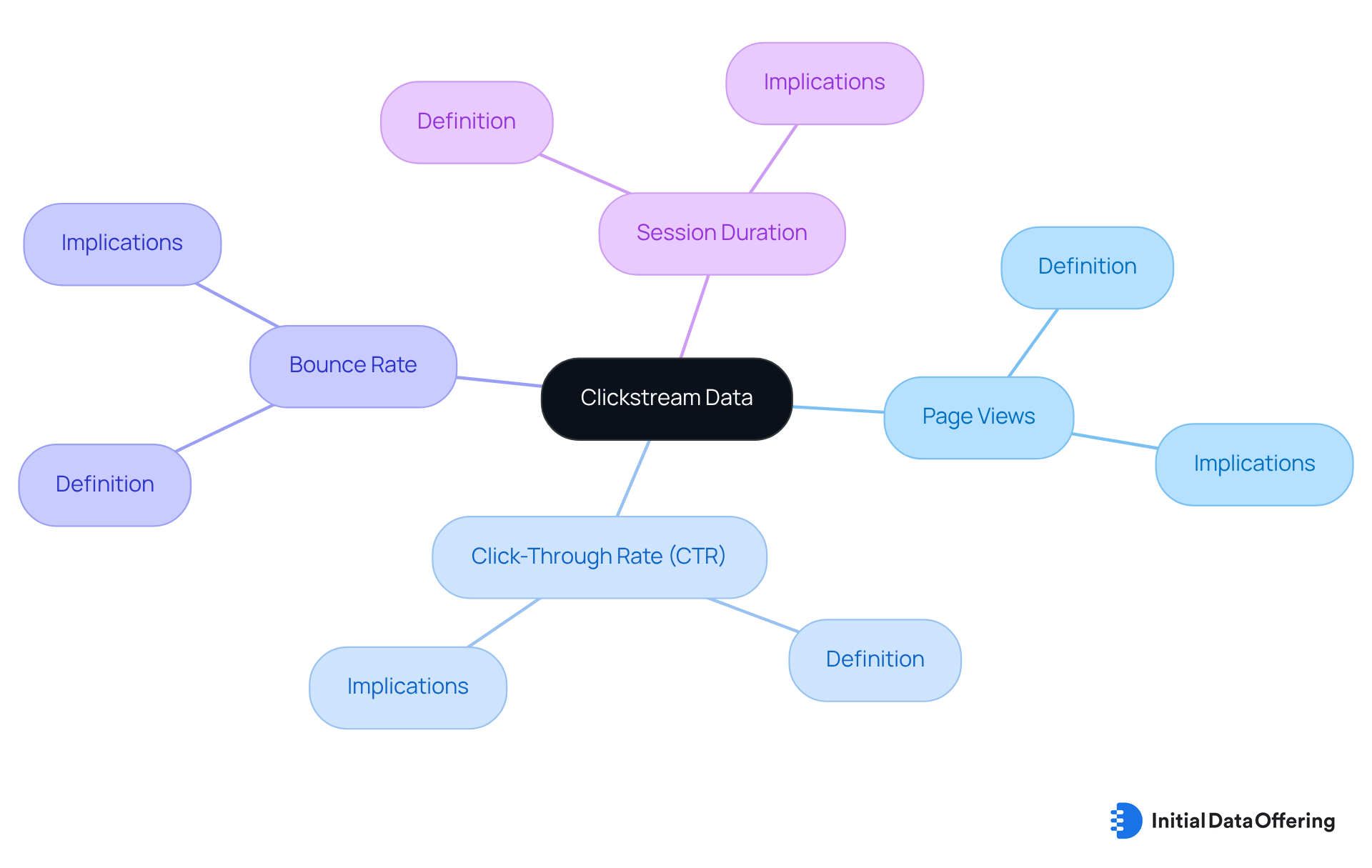What is Clickstream Data? Definition, Context, and Key Insights

What is Clickstream Data? Definition, Context, and Key Insights
Overview
Clickstream data represents a comprehensive digital record of an individual's online activities, capturing every click, page view, and interaction. This data is crucial for organizations aiming to analyze user navigation and behavior on their platforms. By understanding clickstream data, companies gain insights into visitor preferences and engagement levels, which can significantly enhance user experience and marketing strategies.
What if this data could reveal trends that inform website optimization and tailored interactions? The ability to leverage such insights not only improves user satisfaction but also drives business success.
Introduction
Clickstream data acts as a digital breadcrumb trail, capturing the intricate paths users navigate while engaging with online platforms. This rich dataset reveals not only visitor behaviors and preferences but also serves as a powerful tool for organizations to enhance marketing strategies and improve user experiences. As companies increasingly depend on this data to inform their decisions, a critical question emerges: how can they effectively harness clickstream insights to maintain a competitive edge in a rapidly evolving digital landscape? Understanding these insights could transform how businesses approach their online strategies, ultimately leading to more effective engagement with their audiences.
Define Clickstream Data: Understanding Its Core Concept
What is clickstream data? It represents a digital record of an individual's online activity, capturing every click, page view, and interaction on a website or application. This dataset generates a comprehensive path of the individual's experience, illustrating what is clickstream data, and allowing companies to analyze how users navigate their online platforms.
Organizations can gain valuable insights into visitor behavior, preferences, and engagement levels by understanding what is clickstream data, which includes the sequence of clicks and the duration spent on each page.
How can these insights inform your marketing strategies? Ultimately, interaction logs serve as a roadmap for individual engagements and help explain what is clickstream data, providing a wealth of insights that can significantly enhance marketing approaches and improve website functionality.

Contextualize Clickstream Data: Its Role in Digital Analytics
In the field of digital analysis, clickstream data serves as an essential resource for companies aiming to understand consumer behavior and enhance their online visibility. By meticulously examining clickstream data, organizations can uncover trends in navigation, identifying frequent entry and exit points, popular content, and potential bottlenecks in the visitor journey. This insight is invaluable for improving user experience and refining website design, ultimately leading to enhanced conversion rates, illustrating clickstream data. For instance, retailers can leverage browsing data to monitor customer interactions, allowing them to optimize their online shopping platforms and increase customer satisfaction. Furthermore, understanding clickstream data and combining user activity information with other sources, such as demographic and transaction details, provides a comprehensive perspective on customer behavior and preferences.
Recent trends indicate that companies are increasingly focusing on personalized experiences, with 44% of shoppers becoming repeat customers after a customized shopping experience. This statistic underscores the direct impact of user behavior data, specifically clickstream data, in crafting tailored interactions. Firms such as HubSpot exemplify this approach by integrating user behavior information with marketing automation to boost user engagement and conversion rates. As the analytics market is projected to grow significantly, reaching $2.7 billion by 2027, organizations that effectively utilize this information will be better positioned to foster innovation and strategic decision-making. However, challenges such as limited integration with legacy systems persist, highlighting the necessity for businesses to adapt and evolve their analytics strategies.

Trace the Origins of Clickstream Data: Historical Development and Evolution
The concept of user navigation patterns emerged alongside the growth of the internet and web analytics in the late 1990s. As websites began to track visitor interactions to improve user experience and enhance marketing efficiency, interaction data became a crucial asset for understanding online behavior. Initially, the analysis was basic, concentrating on fundamental metrics such as page views and unique visitors. However, advancements in technology and data processing capabilities have significantly transformed the examination of user activity. Today, sophisticated algorithms and machine learning techniques enable businesses to derive deeper insights from what is clickstream data, allowing for real-time analysis and more personalized user experiences.
This evolution is underscored by the increasing demand for information specialists, with a growth rate of 36%, highlighting the rising importance of analytics in business strategy. As Carly Fiorina emphasizes, transforming raw data into actionable insights is vital for creating value, and organizations must leverage these insights to unlock the full potential of their analytics initiatives. Furthermore, the human aspect of data analytics is crucial; algorithms alone cannot answer all questions, and the ability to contextualize insights is essential for meaningful analysis.
This broader understanding of user interaction data signifies a significant shift in how organizations manage information, recognizing its potential to drive innovation and strategic decision-making. How can your organization harness this wealth of data to foster growth? By embracing the insights derived from user navigation patterns, businesses can not only enhance their marketing strategies but also improve overall customer satisfaction.
![]()
Identify Key Characteristics: Metrics and Analysis of Clickstream Data
Key characteristics of what is clickstream data encompass essential metrics such as:
- Page views
- Click-through percentages (CTR)
- Bounce percentages
- Session duration
Page views reflect how many times a particular page has been accessed, providing insight into content popularity. CTR measures the effectiveness of links in driving traffic, indicating how well a site engages visitors. Bounce percentages reveal the proportion of visitors who exit a site after viewing only one page, signaling potential issues with content or visitor engagement. Session duration tracks the total time an individual spends on a site, offering valuable insights into interest and engagement levels.
In 2025, average bounce rates and click-through rates vary significantly across industries. For instance, e-commerce sites generally experience higher bounce rates due to competitive product offerings and heightened consumer expectations. By closely examining these metrics, companies can identify trends, refine their digital strategies, and enhance user experiences. This ultimately leads to improved outcomes and informed decision-making. Current opinions underscore the critical role of these metrics in understanding user engagement, as they provide essential insights into how effectively a website meets its audience's needs.
How can these insights transform your approach? Organizations can better align their digital strategies with user behavior by understanding what is clickstream data, ensuring a more engaging and effective online presence.

Conclusion
Clickstream data serves as a fundamental element in understanding user behavior online, providing a detailed record of every interaction a visitor has with a website or application. This vast dataset reveals how users navigate digital platforms, empowering organizations to tailor their marketing strategies and enhance user experiences. By leveraging clickstream data, businesses gain insights into visitor preferences and engagement levels, ultimately driving improved performance and customer satisfaction.
Throughout the article, key points highlight the importance of clickstream data in digital analytics, its historical evolution, and the critical metrics involved in its analysis. The discussion emphasizes how organizations can utilize this data to identify trends, optimize website functionality, and create personalized experiences for users. Notably, the increasing reliance on data-driven strategies underscores the necessity for businesses to adapt their approaches to remain competitive in the evolving digital landscape.
The insights derived from clickstream data are not just valuable for immediate marketing tactics; they also pave the way for long-term strategic decision-making and innovation. As companies continue to embrace the potential of this data, the call to action is clear: organizations must harness the power of clickstream analytics to unlock deeper understandings of customer behavior, refine their online presence, and ultimately drive growth in an increasingly data-centric world.
Frequently Asked Questions
What is clickstream data?
Clickstream data represents a digital record of an individual's online activity, capturing every click, page view, and interaction on a website or application. It generates a comprehensive path of the individual's experience.
What insights can organizations gain from clickstream data?
Organizations can gain valuable insights into visitor behavior, preferences, and engagement levels, including the sequence of clicks and the duration spent on each page.
How can clickstream data inform marketing strategies?
Clickstream data serves as a roadmap for individual engagements, providing insights that can significantly enhance marketing approaches and improve website functionality.